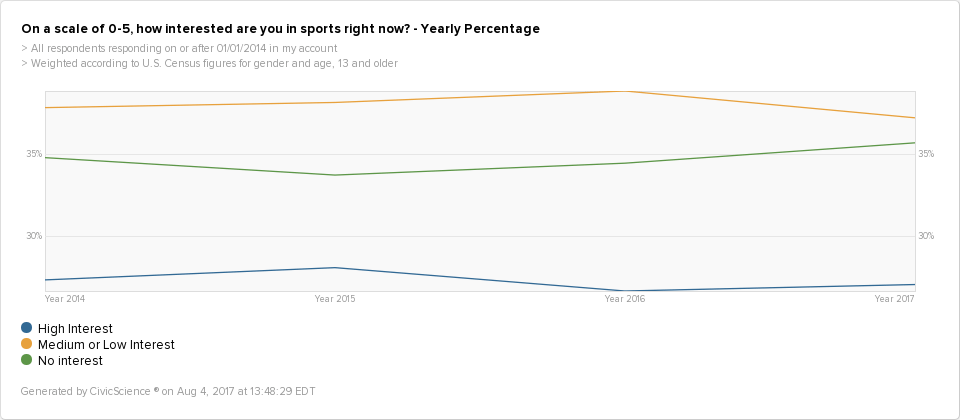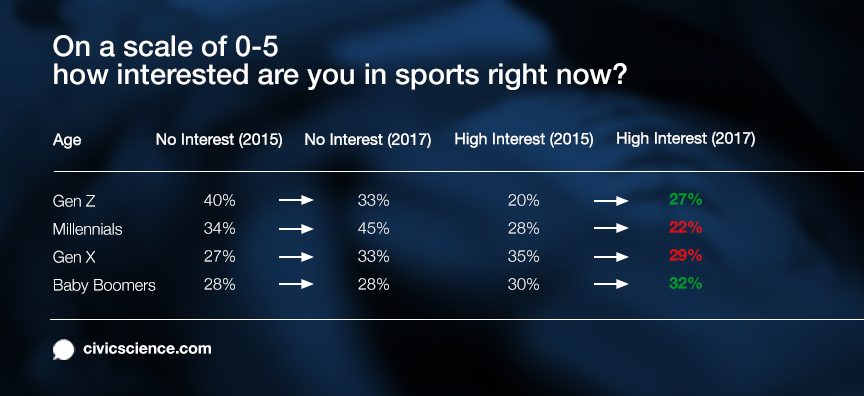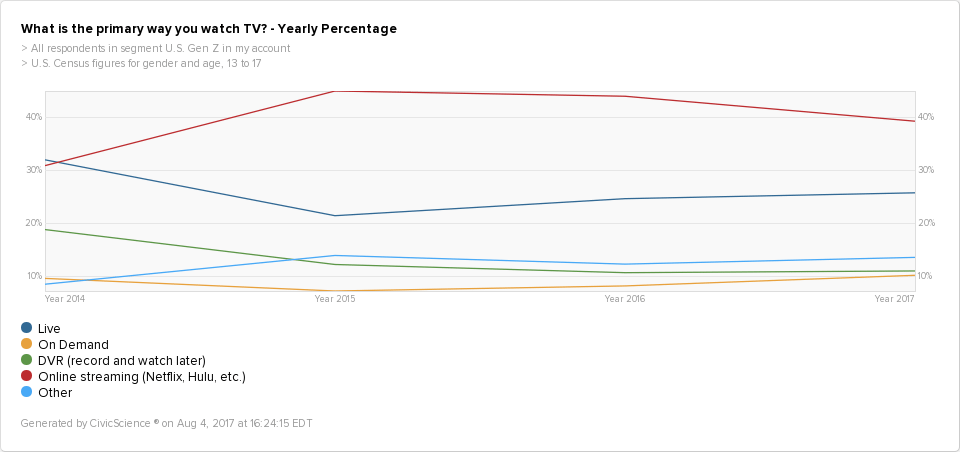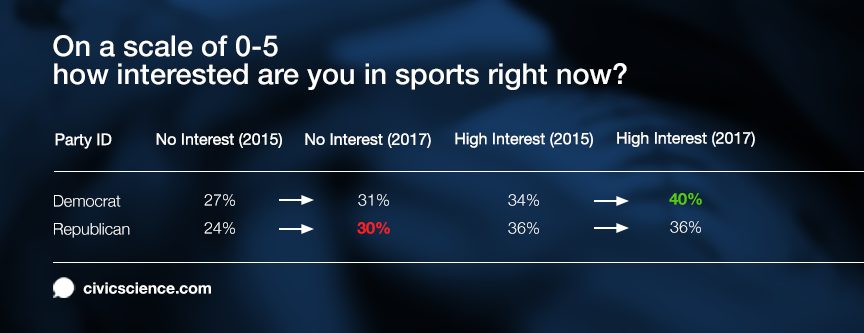The Gist: Although sports fans have shrunk over the past few years, both Gen Z and Baby Boomers defy the national trend, perhaps due to a transition of TV habits. Additionally, the political demographics of sports fans have reversed, as historically Republicans were the top sports fans, but now Democrats have surpassed them.
You know that person at the bar who accidentally cheers for the wrong team, and is met with a wave of dirty gazes from die-hard local sports fans? Yeah. That’s me. Though I may not be a sports expert, I do know some interesting data when I see it.
Whether you’re a sports fan or not, the professional sports leagues have a vast impact on all sorts of industries, from restaurants to advertising. So, the changing demographics of sports fans are something that everyone should pay attention to.
So, where to start? Let’s jump in, here:
Consolidating the 0-5 scale into varying levels of interest, we see that people who have no interest in sports have increased by 2% since last year, while the highly-interested fans haven’t moved an inch. Casual sports fan have seen a drop as well.
This decline in sports interest seems to have hit all generations, except for two.
SPORTS INTEREST GROWS AMONG GEN Z AND BABY BOOMERS
When we look at data before 2016, and data collected after 2017, an interesting narrative develops around age and other demographics.
First, we find that Millennials (18-34) and Gen Xers (35-54) follow suit in regards to the national decline we’re noticing. Before 2016, 28% of Millennials were highly interested in sports, while today only 22% are. Inversely, Millennials who have no interest in sports have grown from 34% to 45% over the same period.
The trend is not as pronounced among Gen Xers, but the numbers are clear. Before 2016, 35% of Gen Xers were highly interested in sports, while the same is true for only 28% today.
However, we’re noticing an opposite phenomenon among those at the tail ends of the generational spectrum.
Before 2016, only 20% of Gen Zers were highly interested in sports, but that number has now risen to 27%. That’s a total increase of 35%. Over the same period, Gen Zers who are not interested in sports have dropped by 7%.
Similar to Gen X, this trend isn’t as evident among Boomers as Gen Zers, but we’d be remiss to not point this out. In the preceding time span, Baby Boomers who say they are highly interested in sports have grown by 2%. While small, it does run against the national trend.
Given the new, younger demographics of die-hard sports fans, it should come as no surprise that these high-interest fans are now more likely to earn a lower income (under $50k) and have a lower level of education when compared to our data pre-dating 2016.
We find this specific generational data interesting for one reason, in particular. There’s been a great deal of national chatter about the state and future of Gen Z, and how they are ditching current trends, and adopting trends that resemble Baby Boomers more than closer-in-age Millennials. Coincidentally (or maybe not), this new data seem to point to the same idea.
The more we research, the more we have to ask, “What the heck is going on with Gen Z?” Fortunately, we have a few years to figure it out before they grow into discretionary spending, and begin to comprise a near-majority of U.S. consumers.
GEN Z IS DITCHING STREAMING – COULD THAT BE A CAUSE?
A more sports-savvy analyst noted that this uptick in sports interest among Gen Z may have to do with TV habits. Currently, there are no streaming services that capture sports in the same way as live TV (though I’m sure that could be debated), so he wondered if their growing interest in sports stems from changing TV habits. As it turns out, he was on to something.
When it comes to Gen Z, online streaming seems to be taking a downturn, while Live TV is making a comeback. Perhaps this is a factor in the sports trend we’re observing.
DEMOCRATS OUTPACE REPUBLICANS AS THE TOP SPORTS FANS
When we take into account the growing age demographics of sports fans, and the fact that younger Americans tend to lean to the political left, this trend isn’t all too shocking. Nonetheless, it’s notable.
Before 2015, 36% of Republicans were highly interested in sports. What’s that number today? Still 36%. Conversely, the percentage of Republicans who now admit to having no interest in sports has increased from 24% to 30% – which represents a change of about 25%.
Now, the opposite is true among Democrats.
Before 2015, only 34% of Democrats were highly interested in sports, and since the beginning of this year, that number has grown to 40%. It seems that many of these new die-hard fans previously had at least a passing amount of interest in sports, illustrated by the 10% decline in the low/medium interest group over the same period that high-interest fans bloomed.
OUT OF THE 4 MAJOR U.S. SPORTS LEAGUES, WHICH ARE SAFE?
Even though we’re noticing a national decline in sports interest, it’s not all bad news. Out of the four major U.S. sports leagues, three leagues have adopted higher interest over the past year – the NBA, NHL and MLB. Fans of the NBA and NHL have each grown by 2 percentage points over the past year, while fans of Major League Baseball have grown by a meager, but notable, 1 percentage point. However, with such a small change each, it’s too early for us to draw any major conclusions.
The NFL has neither gained nor lost fans in recent years, which may be why many sports analysts are worried about the future of football.
DO THE THING, HIT THE BALL
As someone who works in marketing, the repercussions of this data on the lives of marketers and advertisers are especially at the forefront of my consciousness. Companies spend massive amounts of money on sports advertising, and let’s not even talk about the Super Bowl – where this year’s price for a 30-second advertisement ranged from $5 to $5.5 million.
With shrinking budgets and growing demands, it’s more crucial than ever to spend those dollars in the right places, targeting the right people. Given the changing demographics, where a company engaged with its persuadable customers in 2015 may be dramatically different than where they need to reach them today.
That said, sports still remain an invaluable platform for advertising, especially for those hoping to win over the new kid in town – Gen Z.












